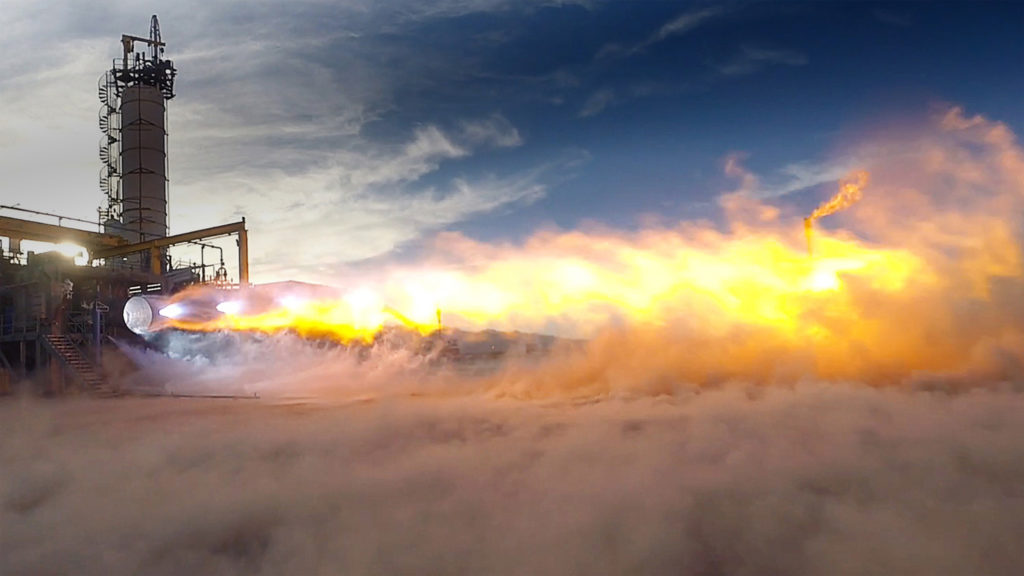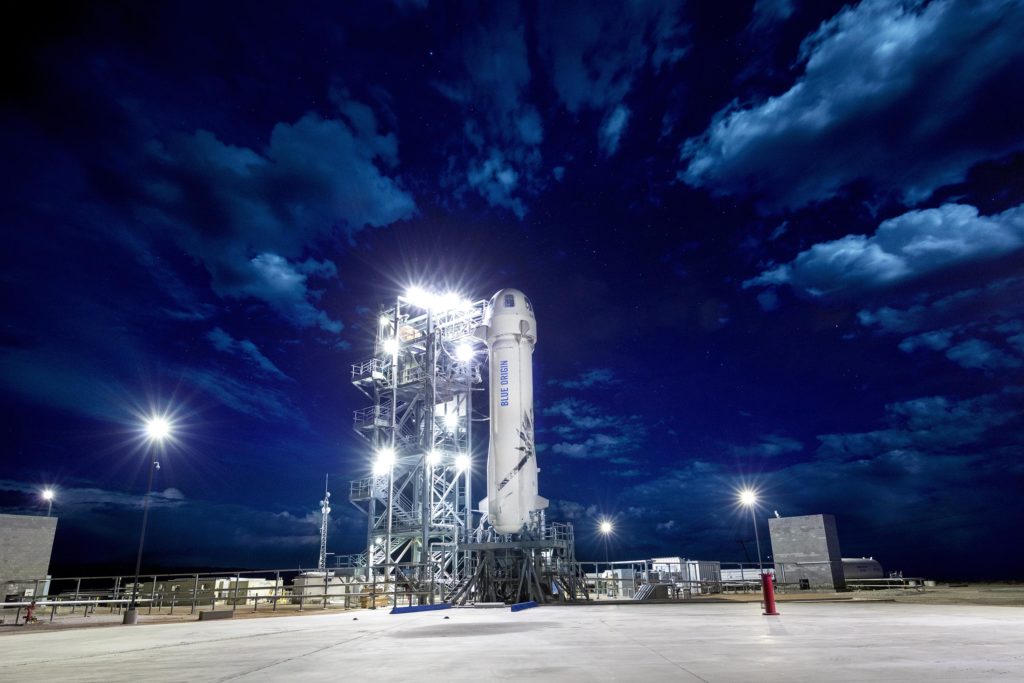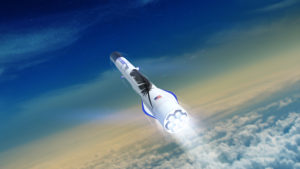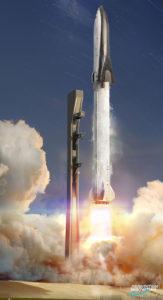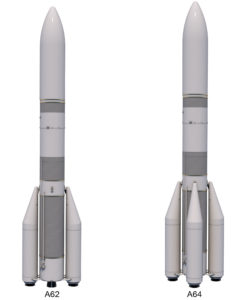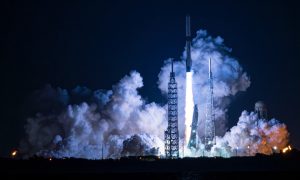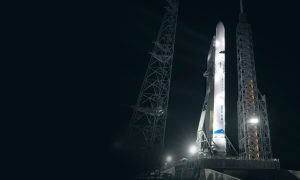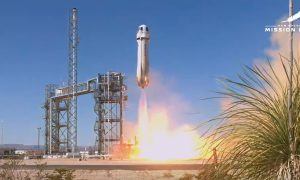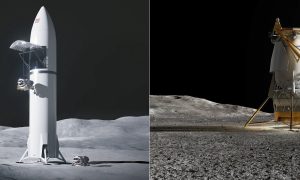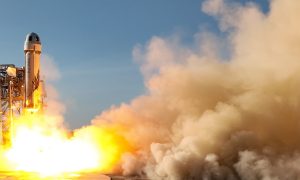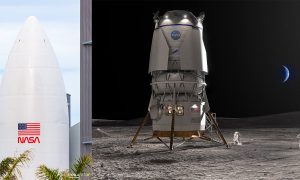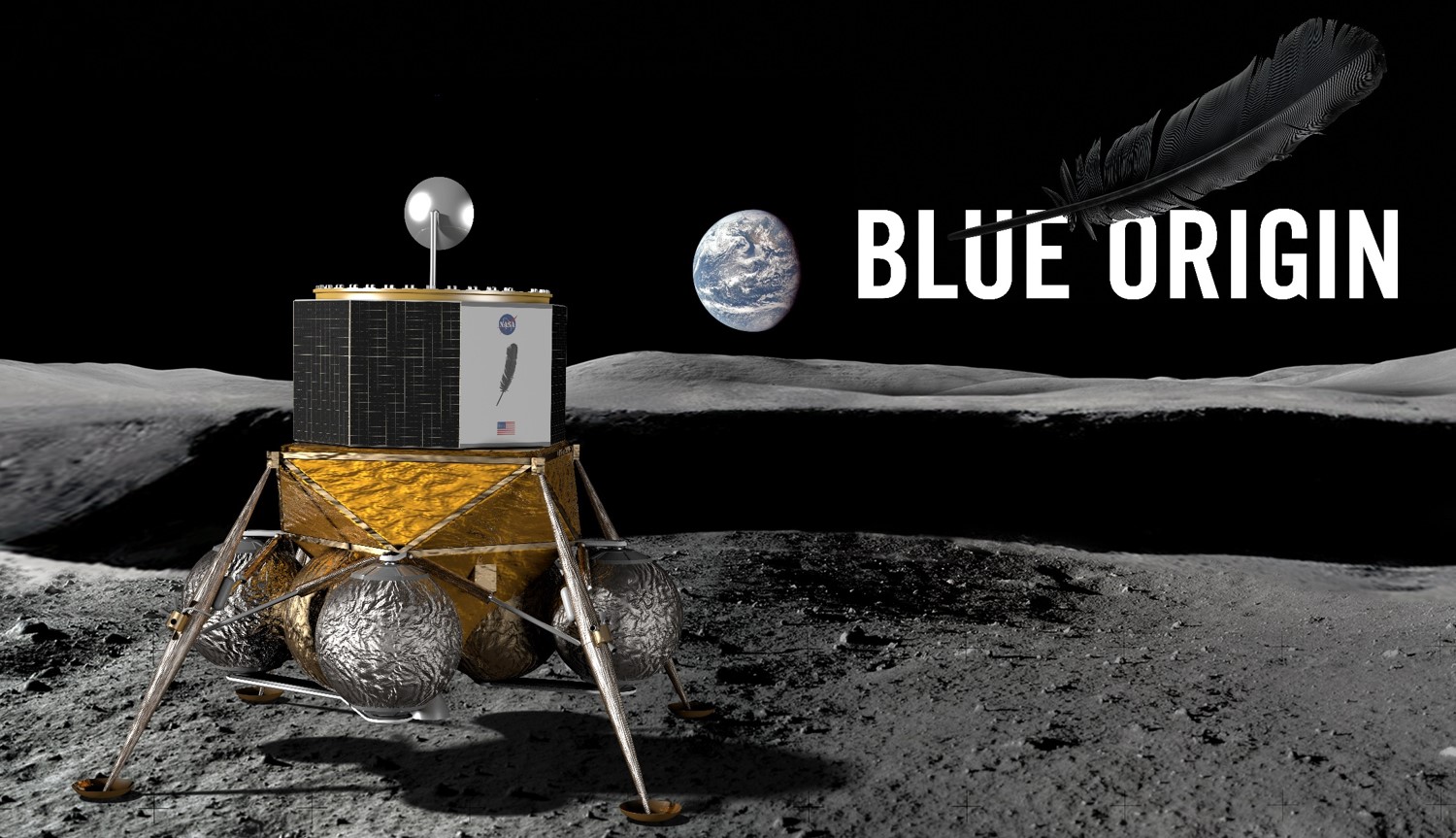

News
SpaceX competitor Blue Origin targets first Moon landing for 2023
Prospective SpaceX competitor and reusable rocket developer Blue Origin detailed its plans earlier this month to enable significant human presence on the Moon and announced a tentative schedule that could see the company begin experimental lunar landing tests of a multi-ton spacecraft just a few years from today – NET 2023.
Funded entirely with stock sales courtesy of founder Jeff Bezos’ lucrative position at the helm of Amazon (not to mention his status as the wealthiest human alive), Blue Origin receives roughly $1 billion annually to develop its space tourism-oriented New Shepard rocket and capsule (suborbital), the magnitudes-larger orbital New Glenn launch vehicle, and a number of other longer-term projects like human colonies in Earth orbit (including the Moon).
In answer to my question, @ac_charania said would evolve to reusable Blue Moon lander. Also under consideration is reusable New Glenn upper stage & faring. https://t.co/Dg3UTN9HU5
— Charles A. Lurio (@TheLurioReport) July 4, 2018
Think SpaceX in terms of ambition (and, perhaps, quality of workforce) but with essentially no existential motivation to field products quickly – framed a bit less flatteringly, Blue Origin moves very slowly when compared with SpaceX. The company was born a full two years before SpaceX and has been working on reusable rockets for at least as long, yet has less than ten launches of a genuinely reusable rocket to claim its own. That rocket, New Shepard, is a purely suborbital, single-stage vehicle intended to enable zero-gee tourism, and is downright minuscule when examined alongside Falcon 9 and Heavy.
- Blue Origin’s BE-4 engine, the propulsion for New Glenn, seen conducting hot-fire tests in Texas. The engine’s nozzles is a full 6 feet (~1.8m) in diameter. (Blue Origin)
- New Shepard ahead of Blue Origin’s most recent suborbital launch, the eighth completed so far. April 2018. (Blue Origin)
New Glenn, however, would truly catapult Blue Origin into a competitive position in the orbital launch business, placing them alongside companies like SpaceX, ULA, and Arianespace. Further, Blue appears to believe that it can design and produce New Glenn boosters capable of as many as 25 flights from the get-go, versus the three years SpaceX spent iteratively design and upgrading its Falcon 9 before arriving at a booster potentially capable of 10-100 reuses. New Glenn’s inaugural launch is currently scheduled for late 2020, and the impressive BE-4 methalox rocket engine powering its first stage is well into serious hot-fire testing, while the engine that will power New Glenn’s upper stage is already successfully flying (albeit as a sea-level variant) on New Shepard.
In a glance, Blue Origin undoubtedly has a lot going for it, although its confidence quite plainly outstrips its the achievements it can actually lay claim to at present. Nevertheless, the company’s Blue Moon project is clearly serious and will build heavily on the (hoped for) successes of New Shepard and New Glenn, integrating the hands-on experience and technologies developed over the course of building and launching both rockets. Presumably depending on New Glenn as the launch vehicle, Blue Origin stated on July 3 that its lunar lander – designed to deliver multiple tons of cargo to the Moon’s surface – could begin experimental Moon missions by 2023 and potentially even sooner if work proceeds exceptionally smoothly.
- Blue Origin’s New Glenn rocket. (Blue Origin)
- SpaceX’s BFR. (Gravitation Innovation/David Romax)
- Credit: NASA-MSFC
- Arianespace’s next-generation Ariane 6. (Arianespace)
- ULA’s upcoming Vulcan rocket. (ULA)
Whether or not Blue Origin manages to make that extraordinarily aggressive scheduled and jumps from suborbital missions to giant orbital reusable rocket launches to multi-ton Moon landings in barely five years, the 2020s are lining up to be an extraordinarily exciting time for spaceflight. With any luck, a veritable fleet of next-generation rockets from Blue Origin, SpaceX, Arianespace, ULA, NASA, Japan, and five or more smaller commercial companies will complete their first launches over the next three years.
Meanwhile, heavyweights SpaceX and Blue Origin may find themselves in a whole different arena, racing to land payloads on the Moon (or perhaps on the Moon and Mars).
News
Tesla begins Robotaxi certification push in Arizona: report
Tesla seems serious about expanding its Robotaxi service to several states in the coming months.

Tesla has initiated discussions with Arizona transportation regulators to certify its driverless Robotaxi service in the state, as per a recent report from Bloomberg News. The move follows Tesla’s launch of its Robotaxi pilot program in Austin, Texas, as well as CEO Elon Musk’s recent comments about the service’s expansion in the Bay Area.
The Arizona Department of Transportation confirmed to Bloomberg that Tesla has reached out to begin the certification process for autonomous ride-sharing operations in the state. While details remain limited, the outreach suggests that Tesla is serious about expanding its driverless Robotaxi service to several territories in the coming months.
The Arizona development comes as Tesla prepares to expand its service area in Austin this weekend, as per CEO Elon Musk in a post on X. Musk also stated that Tesla is targeting the San Francisco Bay Area as its next major market, with a potential launch “in a month or two,” pending regulatory approvals.
Tesla first launched its autonomous ride-hailing program on June 22 in Austin with a small fleet of Model Y vehicles, accompanied by a Tesla employee in the passenger seat to monitor safety. While still classified as a test, Musk has said the program will expand to about 1,000 vehicles in the coming months. Tesla will later upgrade its Robotaxi fleet with the Cyercab, a two-seater that is designed without a steering wheel.
Sightings of Cybercab castings around the Giga Texas complex suggests that Tesla may be ramping the initial trial production of the self-driving two-seater. Tesla, for its part, has noted in the past that volume production of the Cybercab is expected to start sometime next year.
In California, Tesla has already applied for a transportation charter-party carrier permit from the state’s Public Utilities Commission. The company is reportedly taking a phased approach to operating in California, with the Robotaxi service starting with pre-arranged rides for employees in vehicles with safety drivers.
News
Tesla sets November 6 date for 2025 Annual Shareholder Meeting
The automaker announced the date on Thursday in a Form 8-K.

Tesla has scheduled its 2025 annual shareholder meeting for November 6, addressing investor concerns that the company was nearing a legal deadline to hold the event.
The automaker announced the date on Thursday in a Form 8-K submitted to the United States Securities and Exchange Commission (SEC). The company also listed a new proposal submission deadline of July 31 for items to be included in the proxy statement.
Tesla’s announcement followed calls from a group of 27 shareholders, including the leaders of large public pension funds, which urged Tesla’s board to formally set the meeting date, as noted in a report from The Wall Street Journal.
The group noted that under Texas law, where Tesla is now incorporated, companies must hold annual meetings within 13 months of the last one if requested by shareholders. Tesla’s previous annual shareholder meeting was held on June 13, 2024, which placed the July 13 deadline in focus.
Tesla originally stated in its 2024 annual report that it would file its proxy statement by the end of April. However, an amended filing on April 30 indicated that the Board of Directors had not yet finalized a meeting date, at least at the time.
The April filing also confirmed that Tesla’s board had formed a special committee to evaluate certain matters related to CEO Elon Musk’s compensation plan. Musk’s CEO performance award remains at the center of a lengthy legal dispute in Delaware, Tesla’s former state of incorporation.
Due to the aftermath of Musk’s legal dispute about his compensation plan in Delaware, he has not been paid for his work at Tesla for several years. Musk, for his part, has noted that he is more concerned about his voting stake in Tesla than his actual salary.
At last year’s annual meeting, TSLA shareholders voted to reapprove Elon Musk’s compensation plan and ratified Tesla’s decision to relocate its legal domicile from Delaware to Texas.
Elon Musk
Grok coming to Tesla vehicles next week “at the latest:” Elon Musk
Grok’s rollout to Tesla vehicles is expected to begin next week at the latest.

Elon Musk announced on Thursday that Grok, the large language model developed by his startup xAI, will soon be available in Tesla vehicles. Grok’s rollout to Tesla vehicles is expected to begin next week at the latest, further deepening the ties between the two Elon Musk-led companies.
Tesla–xAI synergy
Musk confirmed the news on X shortly after livestreaming the release of Grok 4, xAI’s latest large language model. “Grok is coming to Tesla vehicles very soon. Next week at the latest,” Musk wrote in a post on social media platform X.
During the livestream, Musk and several members of the xAI team highlighted several upgrades to Grok 4’s voice capabilities and performance metrics, positioning the LLM as competitive with top-tier models from OpenAI and Google.
The in-vehicle integration of Grok marks a new chapter in Tesla’s AI development. While Tesla has long relied on in-house systems for autonomous driving and energy optimization, Grok’s integration would introduce conversational AI directly into its vehicles’ user experience. This integration could potentially improve customer interaction inside Tesla vehicles.
xAI and Tesla’s collaborative footprint
Grok’s upcoming rollout to Tesla vehicles adds to a growing business relationship between Tesla and xAI. Earlier this year, Tesla disclosed that it generated $198.3 million in revenue from commercial, consulting, and support agreements with xAI, as noted in a report from Bloomberg News. A large portion of that amount, however, came from the sale of Megapack energy storage systems to the artificial intelligence startup.
In July 2023, Musk polled X users about whether Tesla should invest $5 billion in xAI. While no formal investment has been made so far, 68% of poll participants voted yes, and Musk has since stated that the idea would be discussed with Tesla’s board.
-

 Elon Musk1 week ago
Elon Musk1 week agoTesla investors will be shocked by Jim Cramer’s latest assessment
-

 Elon Musk3 days ago
Elon Musk3 days agoElon Musk confirms Grok 4 launch on July 9 with livestream event
-

 Elon Musk14 hours ago
Elon Musk14 hours agoxAI launches Grok 4 with new $300/month SuperGrok Heavy subscription
-

 News7 days ago
News7 days agoTesla Model 3 ranks as the safest new car in Europe for 2025, per Euro NCAP tests
-

 Elon Musk2 weeks ago
Elon Musk2 weeks agoA Tesla just delivered itself to a customer autonomously, Elon Musk confirms
-

 Elon Musk1 week ago
Elon Musk1 week agoxAI’s Memphis data center receives air permit despite community criticism
-

 Elon Musk2 weeks ago
Elon Musk2 weeks agoTesla’s Omead Afshar, known as Elon Musk’s right-hand man, leaves company: reports
-

 News2 weeks ago
News2 weeks agoXiaomi CEO congratulates Tesla on first FSD delivery: “We have to continue learning!”

